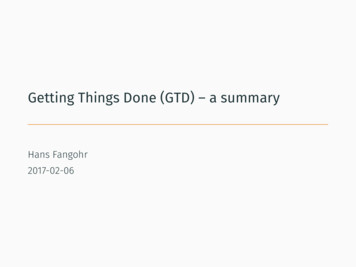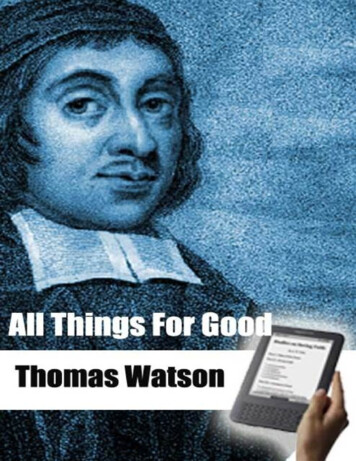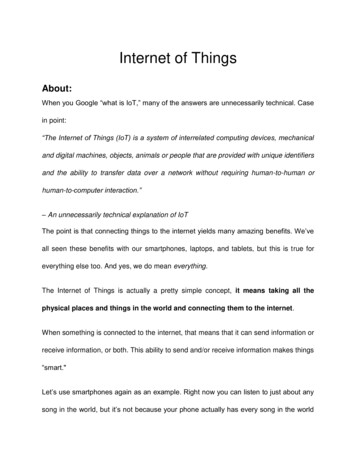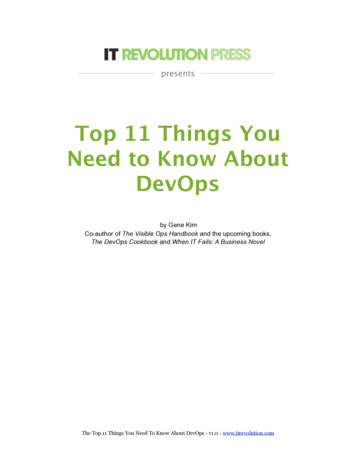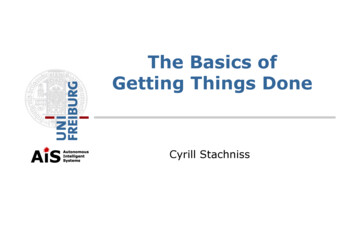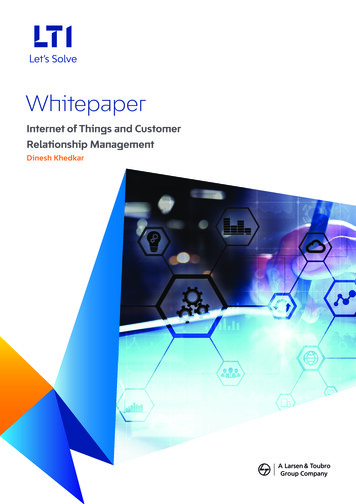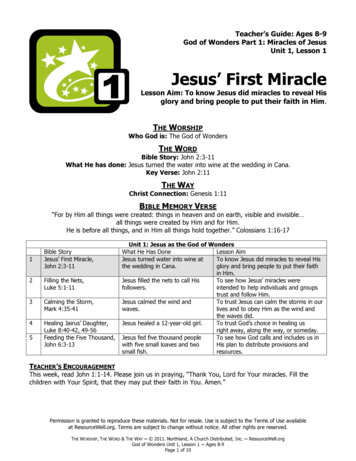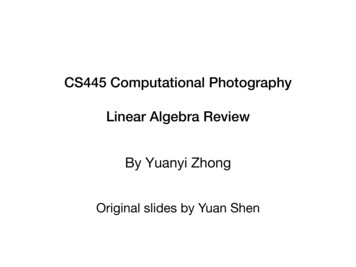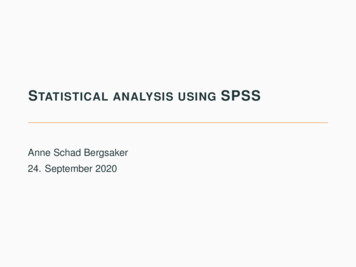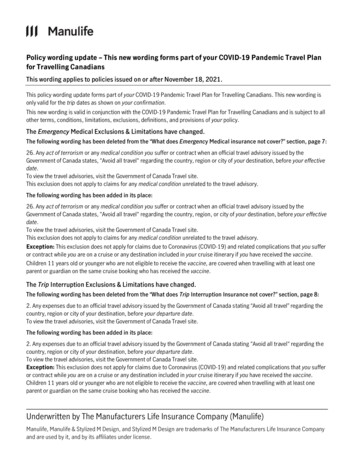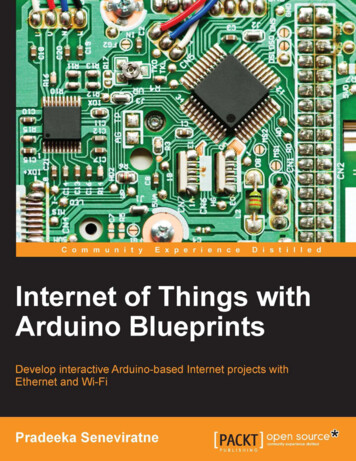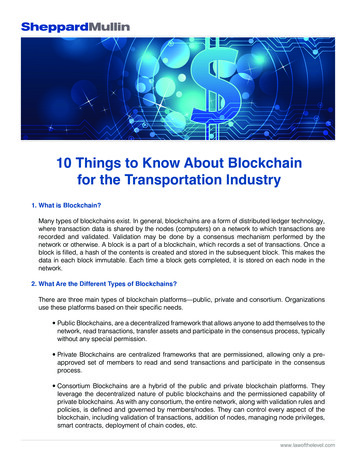
Transcription
10 Things to Know About Blockchainfor the Transportation Industry1. What is Blockchain? any types of blockchains exist. In general, blockchains are a form of distributed ledger technology,Mwhere transaction data is shared by the nodes (computers) on a network to which transactions arerecorded and validated. Validation may be done by a consensus mechanism performed by thenetwork or otherwise. A block is a part of a blockchain, which records a set of transactions. Once ablock is filled, a hash of the contents is created and stored in the subsequent block. This makes thedata in each block immutable. Each time a block gets completed, it is stored on each node in thenetwork.2. What Are the Different Types of Blockchains? here are three main types of blockchain platforms—public, private and consortium. OrganizationsTuse these platforms based on their specific needs. Public Blockchains, are a decentralized framework that allows anyone to add themselves to thenetwork, read transactions, transfer assets and participate in the consensus process, typicallywithout any special permission. Private Blockchains are centralized frameworks that are permissioned, allowing only a preapproved set of members to read and send transactions and participate in the consensusprocess. Consortium Blockchains are a hybrid of the public and private blockchain platforms. Theyleverage the decentralized nature of public blockchains and the permissioned capability ofprivate blockchains. As with any consortium, the entire network, along with validation rules andpolicies, is defined and governed by members/nodes. They can control every aspect of theblockchain, including validation of transactions, addition of nodes, managing node privileges,smart contracts, deployment of chain codes, etc.www.lawofthelevel.com
3. What are Crypto Currencies and Tokens? cryptocurrency is a digital currency that uses cryptography for security and for which transactionsAare typically recorded to a blockchain. Tokens can be a currency but can be programmed toinclude additional functionality, such as ownership of title, voting rights, distribution rights, and otherfunctionality. Recordation of ownership of currencies and tokens occurs via a blockchain. Typicallythis is implemented using public key/private key encryption. The “keys” are long strings of numbersand letters linked through the mathematical encryption algorithm that was used to create them. Thepublic key (comparable to a bank account number) serves as the address which is disclosed toothers and to which others may send currencies and tokens. The private key (comparable to anATM PIN) is meant to be a guarded secret, and only used to authorize transfers or transmissionsassociated with the currencies or tokens. Crypto currencies and tokens can be bought and sold (ortraded) via exchanges and can be transferred in a peer-to peer manner. Transfers can occur via asoftware “wallet,” which is associated with a user or device, has a unique alphanumeric identifier andcan transfer and receive crypto currencies and tokens.4. What are Smart Contracts? mart contracts are essentially self-executing contracts with the operational terms of the agreementSbetween buyer and seller being directly written into and executed by lines of code. The code and theagreements contained therein can exist across a distributed, decentralized blockchain network. Usinga scripting language or other techniques, a smart contract can include logic-based programs run ontop of a blockchain. A smart contract can receive data from various sources and programmaticallyimplement a series of if-then rules that are performed at least in part by computers without the needfor third-party human interaction.5. What is the Internet of Things (IoT)? he IoT is a network of sensor-enabled devices that can collect data, communicate via the internetTor other networks and, if programmed to do so, execute transactions or take other actions based ona predetermined set of conditions. As examples, car, trucks and cargo can be sensor-enabled tocollect and transmit data.6. How are Auto Makers Using Blockchain?So much is in the works. Here are some examples. T oyota — announced in May 2017 that it is exploring blockchain and distributed ledgertechnology (BC/DL) for use in the development of a new mobility ecosystem that couldaccelerate development of autonomous driving technology. It is working in at least three areasof the new mobility ecosystem: driving/testing data sharing, car/ride share transactions andusage-based insurance. Driving/Testing Data Sharing: Blockchain technology may allow companies andindividuals to securely share and monetize their driving information and access the datacontributed by others in a secure marketplace. Modern vehicles are increasingly aware oftheir environment through onboard sensors and are increasingly connected to the cloud,roadway infrastructure and other vehicles, all of which are generating massive amountsof valuable data. BC/DL may create an opportunity to share driving and autonomoustesting data in an environment that preserves ownership of the data by the creator.www.lawofthelevel.com
Car/Ride Share Transactions: Tools based on BC/DL have the potential to empowervehicle owners to monetize their asset by selling rides, cargo space or even the useof the vehicle itself. The blockchain can store data about the vehicle’s usage andinformation about vehicle owners, drivers and passengers. This profile information canhelp validate a “smart contract” between two parties plus manage payment of servicesbetween them without need of a financial intermediary, thereby saving transactionsurcharges. The system may also provide connectivity to vehicle functions for remotelocking/unlocking doors and engine startup/shut off. Usage-Based Insurance: The blockchain can also be used for vehicle owners to savemoney on their insurance rates. By allowing the vehicle’s sensors to collect drivingdata and store it in a blockchain, vehicle owners may be eligible to further lower theirinsurance costs by giving their insurance companies increased transparency to reducefraud plus granting them access to driving data to measure safe driving habits. P orsche — has announced that it is the first automobile manufacturer to implement and successfullytest blockchain in a car. The applications tested include locking and unlocking the vehicle via anapp, temporary access authorizations and new business models based on encrypted data logging.This could be developed further, for example, to improve autonomous driving functions. Accordingto Porsche: the services developed on the foundation of blockchain are fast and very secure. Thecar becomes part of the blockchain, making a direct offline connection possible – thatis, without diversion through a server. Taking 1.6 seconds, the process of opening andclosing the car via an app is up to six times faster than before. In addition, efficientcryptographic encryption takes place. This process ensures that all activities aredocumented in the blockchain in a way that prevents them from being modified, andcan be viewed using an app. For example, access authorizations can be distributeddigitally and securely and can be monitored by the vehicle owner at any time. Accessalso works remotely. the technology makes it possible to assign temporary access authorizations for thevehicle – in a secure and efficient manner. A protected connection to vehicle data andfunctionalities can be established using blockchain. At the same time, it protects allcommunication between participants. Third-party providers can be integrated withoutthe need for additional hardware, simply by using “smart contracts.” new blockchain-based business models are enabled. The system could create anextremely fast and secure network for electric car charging station availability andpayment. Further into the future, it may also prove essential to self-driving cars.Information from a self-driving Porsche on road conditions, could be uploaded anddistributed across the blockchain. From there, other vehicles’ software connected tothe system could access and analyze the information to provide a warning to trafficcongestion or inclement weather.www.lawofthelevel.com
IBM announced is working with ZF Friedrichshafen AG and UBS to develop the firstblockchain-based automotive transaction platform for mobility services. This sharedledger technology will enable secure and transparent in-vehicle payments, so thatmotorists can pay for tolls, parking, car sharing and eBattery charging on the go andreceive payments for car sharing. An important part of achieving this vision is thedevelopment of a reliable, autonomous agent that will enable cars to respond to theirenvironment, navigate routes and perform diagnostic checks without human input.How cool will it be when your autonomous car can drive to Starbucks, order yourfavorite coffee drink on its way, pay for it with its ewallet, pick it up at the drive-throughand deliver it to you?7. What is a Mobility Ecosystem?The following image depicts the future state of mobility according to a Deloitte report:Photo Attribution: Deloitte University Press, dupress.deloitte.comwww.lawofthelevel.com
The emergence of these four future states catalyzes a new mobility ecosystem that is connected,seamless, efficient, and intermodal. Value in this new ecosystem is derived from consumer-centric data,systems, and services-oriented business models.The pillars of a decentralized mobility platform include the convergence of the internet, blockchain,energy systems, on-board sensors, ewallets and mobility/logistics to create a new transaction layer. Thisis referred to as an open decentral mobility platform and enables cars to autonomously communicateand transact with a number of entities.Photo Attribution: World Economic Forum, weforum.org8. How is Blockchain being used in Supply Chains? any supply chains will be transformed by blockchain technology. Transportation, as part of thoseMsupply chains, is no exception. Walmart is testing blockchain technology for its supply chain. Maerskthe world’s largest shipping company, working with IBM, has recently completed a test of managingthe company’s cargos using blockchain. ccording to Morgan Stanley, blockchain has the potential to join autonomous trucks, drones, andAthe ‘uberization’ of freight as a key disruptive technology that can bring operating and cost efficiencyto supply chains. It noted there are numerous potential uses, particularly in areas related to security,automation, and supply-chain visibility. It added that at a basic level, the secure, transparent andautomated nature of blockchain technology can allow for smooth, speedy and secure executionof contracts across the supply chain thereby eliminating physical documentation and manualinvolvement by automating contract execution and delivery from initiation through payment (throughsmart contracts).”www.lawofthelevel.com
9. How is Blockchain being used in the Transportation Industry? he following is an overview of some aspects of the transportation industry that are anticipated to beTaffected by blockchain (according to the Blockchain In Transport Alliance).Transportation Applications of BlockchainPhoto Attribution: TMW Systems, supplychain247.comAccording to a recent article proponents of blockchain technology have identified a wide variety ofpotential applications that would benefit the providers and commercial users of transportation andlogistics services, such as:Foiling Imposter Carriers. Shippers sometimes fall victim to schemes whereby a fraudster masqueradesas a legitimate carrier. For instance, the criminal intercepts information about a high-value load, arrives atthe point of origin ahead of the legitimate carrier, obtains possession of the load with forged documents,and readily vanishes to fence the goods. However, blockchain may permit the shipper to identify a givencarrier as an imposter if the carrier lacks the proper credentialing record created through blockchaintechnology.Accelerating Load Tenders. A shipper or freight broker having control of a load could tag the loadwith an RFID chip containing points of origin and destination, rate, or other criteria. The RFID chipwould be connected to a network such that carrier software could automatically search and bid onthe transportation of the load based on predetermined rules. The load tender and acceptance wouldhappen without human intervention.Track and Trace. A pallet or other load tagged with an RFID chip could be tracked and traced viablockchain technology as that particular load moved through various locations having access to theinternet, creating a detailed record of the load’s pedigree and chain of custody. Having this data isparticularly beneficial for those involved in the transportation of pharmaceuticals or food products—even more so when a product recall need arises.www.lawofthelevel.com
Expediting Payment. Shippers and carriers could enter smart contracts where the rules provide thatpayment is automatically made when a given load arrives at destination under various conditions. Forinstance, carriers may no longer need to devote substantial resources to billing and collection effortsif the network itself (rather than a third party) validates the blockchain such that payment is madeautomatically. This might also mean that certain carriers would no longer need to factor receivables.Minimizing Claims. The same application of blockchain to track and trace cargo could be used tominimize claims. For instance, whether the load or the truck itself is tagged, a blockchain record willdevelop showing the time of pick-up and delivery, thereby creating unalterable evidence as to whethera given load was delivered timely or not.Leveling the Playing Field. Many of the examples above illustrate how blockchain technology willbenefit smaller carriers with limited resources by providing them faster payment, more expeditiousclaims handling, more and easier bid opportunities, and the like. By empowering smaller carriers,blockchain technology promises to make the transportationSimilarly, the combination of IoT and Blockchain can be used to ensure safe delivery of perishable foodproducts by controlling and documenting the temperature throughout the transportation process. It alsocan be used to automate order fulfillment, invoicing and settlements using smart contracts.In terms of telematics, it would enable manufacturers to add more sensors to help service centerssecurely capture and store engine diagnostics data and other vehicle performance information. Thiscan be used with machine-learning algorithms to determine when a vehicle will require maintenance.This is just the tip of the iceberg. Many more applications will emerge.Additional ReferencesNoteworthy OrganizationsBlockchain In Transport Alliance a forum for the development of blockchain standards and educationfor the freight industry whose goal is to bring together leading companies in the freight technologyindustries that have a vested interest in the development of blockchain technology.TMW (a Trimble Company) - Blockchain Engineering Standards for Transportation & Logistics (BEST-L)invites blockchain architects, developers, DevOps, network administrators and technical gurus, tocollaborate and establish open engineering standards for transportation and logistics industry.Vinchain - is creating a worldwide decentralized database of vehicle information that is 100%transparent, reliable, and accessible by everyone. This database is blockchain based to guaranteethat the information in it has not been faked, changed, or deleted. Information is captured from countryregistries, insurance and leasing companies, different partnered services, private registers, paid APIs,and certified members. Information is also captured directly from the vehicle, so the data is live andupdated in real time.www.lawofthelevel.com
ArticlesBlockchain in logistics and transportation: Transformation aheadBlockchain for transportationMorgan Stanley - “Just as internet has transformed our lives with email, e-commerce, or smartphoneapps, we believe blockchain as an infrastructure technology can power future disruptive technologiesthrough distributive ledgers, smart contracts, tokens or identity management.”For more information, please contact James Gatto (Blockchain and Digital Currency Team Leader) atjgatto@sheppardmullin.com or at 202-747-1945.www.lawofthelevel.com
Many supply chains will be transformed by blockchain technology. Transportation, as part of those supply chains, is no exception. Walmart is testing blockchain technology for its supply chain. Maersk the world's largest shipping company, working with IBM, has recently completed a test of managing the company's cargos using blockchain.
